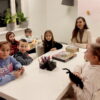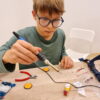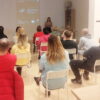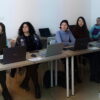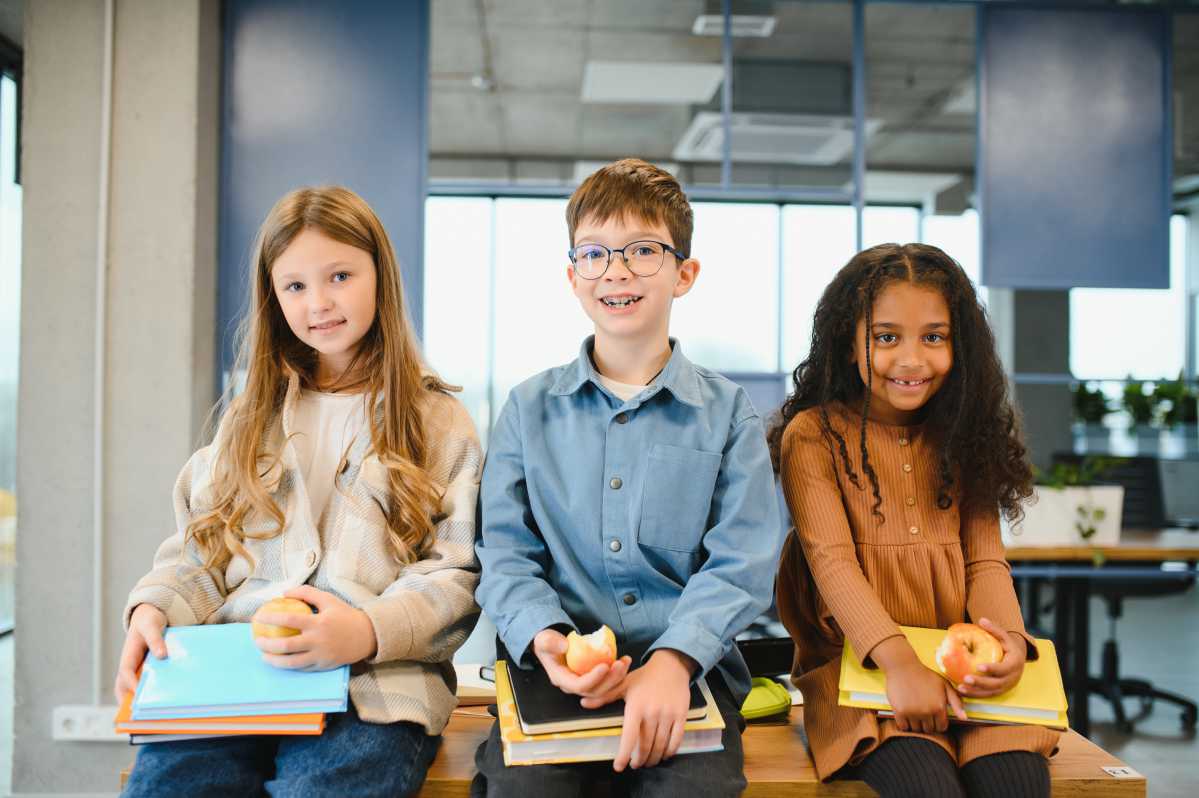
PROBLEM STATEMENT
In the bustling world of today, where technology and creativity forge the future, a significant gap looms large — a gap between our children and their understanding of the endless possibilities that modern professions offer. The “Educational Fundraiser: Interactive Hands-On Series for Children” aims to bridge this gap, addressing the critical issue that many children remain unaware of the potential careers and innovations at their fingertips. This unawareness is not just a lack of information but a missing link in their educational journey, which, if addressed early, can transform their future.
The importance of introducing children to technology and creativity at a young age cannot be overstated. In a world where digital literacy and innovative thinking are paramount, the lack of access to modern technologies and creative tools for children is a barrier to their development. This program recognizes that the high entry barrier and limited access to cutting-edge technologies and instruments restrict children’s ability to explore and learn. Furthermore, the prevalent focus on theoretical learning dampens the spirit of inquiry and innovation among the young minds, creating a disconnection between what they learn and how it applies in the real world.
The existing educational content often misses the mark in combining the interests of children and teenagers with practical knowledge application. This disconnect not only hinders their learning but also fails to prepare them for the rapidly evolving job market. The integration of modern technologies into traditional educational systems remains a challenge, leaving children underprepared for a technologically advanced world. Additionally, the opportunities for cultivating creative and engineering thinking from an early age are limited, further widening the gap between potential and opportunity.
This program also highlights a critical shortage of educational initiatives that promote teamwork and leadership qualities among children. The absence of platforms that cater to the diverse interests and needs of children of various ages is a significant barrier to inclusive education. Moreover, conventional educational programs often overlook practical lessons in technology and the arts, leading to a loss of interest among students who crave engagement and hands-on experience.
Access to contemporary educational resources remains a dream for many families, leaving children without a clear path to develop their interests. Stimulating creative and critical thinking from childhood is essential yet challenging in the absence of supportive programs. Additionally, children from disadvantaged backgrounds face even greater hurdles in accessing quality education, a situation exacerbated by the pandemic, which has underscored the need for innovative educational approaches.
Key POINTS
- Gap in awareness: many children are unaware of the possibilities modern professions and technologies offer.
- Importance of early exposure: early introduction to technology and creativity is crucial for children’s development.
- Access and engagement: limited access to technologies and a focus on theoretical learning limit children’s engagement and interest.
- Preparation for the future: current educational content often fails to prepare children for the rapidly changing job market and technological advancements.
- Need for practical learning: a lack of educational programs that combine interests with practical application and promote essential skills like teamwork and leadership.
- Inclusivity challenges: the absence of adaptive educational platforms for all ages and backgrounds, particularly in the wake of the pandemic’s impact on education.
PROJECT GOALS
At the heart of the “Educational Fundraiser: Interactive Hands-On Series for Children” lies a set of ambitious yet attainable goals designed to revolutionize the educational landscape for young minds. This initiative aims to create an accessible and inspiring educational program that not only captivates the interest of children but also nurtures their passion for learning and self-development through practical and interactive sessions. The vision is to foster a generation of learners who see education not as a chore but as an exciting journey of discovery and innovation.
One of the primary objectives of this program is to cultivate critical thinking, creativity, and engineering skills among children. By engaging them in hands-on activities that challenge their intellect and imagination, the program seeks to unlock their potential and guide them towards realizing their capabilities. This approach is pivotal in preparing them for the challenges and opportunities of a future dominated by high technology and rapid innovation.
Ensuring equal access to modern technologies and knowledge for children from diverse backgrounds is a cornerstone of this initiative. It underscores the commitment to democratize education and offer every child, irrespective of their socio-economic status, the opportunity to engage with and benefit from the advancements in science and technology. This inclusive approach is fundamental in leveling the playing field and offering every child a fair chance at success.
The program is dedicated to incorporating innovative teaching methodologies that encourage active participation and engagement among students. By doing so, it aims to transform the traditional educational model into a dynamic and interactive experience that stimulates the desire to learn and explore. Furthermore, it seeks to instill an understanding of the importance of lifelong learning and self-improvement, highlighting that education is a continuous journey that extends beyond the classroom.
Leadership qualities and teamwork are also key focus areas, with the program designed to foster collaboration and communication among students. Through group projects and cooperative tasks, children learn the value of working together towards a common goal, thereby enhancing their social skills and leadership potential.
Moreover, the initiative aims to draw society’s attention to the critical need for practical education that prepares children for the realities of the modern world. By showcasing the impact of hands-on learning, the program advocates for a shift in educational priorities towards more applied and experiential learning opportunities.
Lastly, the program endeavors to provide children with the tools and guidance needed to explore their interests and identify potential career paths. Through exposure to various fields of study and professional disciplines, it helps children to envision their future and encourages them to dream big.
The series includes various hands-on session series, for example, “The Power of Engineering,” “Young Filmmaker,” “The Art of Reportage Photography,” “Practical Electronics,” “Robotics Workshop,” “Acting Dynamics,” “Websites Made Simple,” “AI Practices,” and many similar others.
Key POINTS
- Creating an inspiring educational program: accessible, motivating, and engaging for children, encouraging a love for learning through interactive activities.
- Fostering essential skills: developing critical thinking, creativity, and engineering skills to prepare children for a technologically advanced future.
- Ensuring equal access: democratizing access to modern technologies and knowledge for all children, regardless of their background.
- Innovative teaching methods: incorporating interactive and participative educational practices to enhance learning experiences.
- Promoting lifelong learning: instilling the importance of continuous education and self-improvement in children.
- Leadership and teamwork: encouraging collaborative skills and leadership qualities among students, preparing them for future challenges.
IMPLEMENTATION METHODS
To turn the ambitious goals of this program into reality, a comprehensive and innovative implementation strategy is essential. The approach encompasses a series of targeted actions and methodologies designed to maximize learning outcomes and engage young minds actively. Here’s a breakdown of the methodologies that form the backbone of this transformative educational program.
- Organizing practical sessions with experts: hands-on workshops will be directly organized, featuring experts from various fields. These sessions are designed to provide children with real-world experiences and insights into different professional domains, sparking curiosity and inspiration.
- Integrating gamification and interactive technologies: the curriculum will incorporate game elements and interactive technologies to make learning more engaging and fun. By blending education with play, students are more likely to participate actively and retain the information they learn.
- Developing modular learning programs: children will have the flexibility to choose their learning paths thanks to modular programs. This approach allows learners to pursue their interests at their own pace, fostering a sense of autonomy and motivation.
- Applying project-based learning methods: to cultivate problem-solving skills, the program will employ project-based learning strategies. Students will tackle real-world challenges, working in teams to devise and implement solutions, mirroring the collaborative nature of professional environments.
- Engaging parents in the learning process: recognizing the vital role of parental support in education, the program plans to involve parents through joint activities and projects. This collaboration strengthens the learning ecosystem and encourages family bonding over educational pursuits.
- Using adaptive educational technologies: to address the unique learning styles and paces of each child, the program will leverage adaptive technologies. These tools personalize the learning experience, ensuring that all students can achieve their full potential.
- Creating specialized educational materials: a suite of custom-designed textbooks and materials, which blend theory with practical application, will be developed. These resources are intended to enrich the learning experience, providing a solid foundation and context for the practical activities.
- Launching an online platform: an online platform will be established to offer unrestricted access to educational content. This digital resource center will enable continuous learning beyond the classroom, accommodating students’ schedules and preferences.
- Providing feedback and mentorship: continuous improvement will be facilitated through regular feedback and mentorship. This supportive framework aims to help students refine their skills and knowledge, encouraging a culture of continuous learning and self-improvement.
- Organizing competitions and project work: to foster a spirit of teamwork and healthy competition, the program will organize contests and group projects. These activities are designed to enhance collaborative skills and competitiveness, preparing students for the challenges of the future workplace.
Key POINTS
- Direct organization of hands-on workshops with field experts to inspire and educate.
- Integration of gamification and interactive technologies for enhanced engagement.
- Development of modular learning programs for personalized education paths.
- Application of project-based learning to develop real-world problem-solving skills.
- Engagement of parents and use of adaptive educational technologies for personalized learning experiences.
- Creation of specialized materials and an online platform for comprehensive learning support.
- Implementation of feedback, mentorship, and competitive activities to cultivate a comprehensive skill set.
IMPLEMENTATION PHASES
Our program is set to unfold in a meticulously planned series of stages, each designed to ensure the program’s success and sustainability. This step-by-step approach allows for thorough preparation, execution, and expansion, guaranteeing that the educational series meets the needs of its target audience while maintaining high-quality standards. Here are the detailed stages of implementation:
- Needs and interests analysis: the initial phase involves analyzing the needs and interests of the target audience to determine the program’s key directions. This ensures that the curriculum is relevant and engaging for the students.
- Curriculum development and mentor selection: the next step is to develop educational curriculums and select mentors for each practical session direction. This foundational work lays the groundwork for the program’s content and instructional quality.
- Creation and testing of educational materials: before full-scale implementation, educational materials are created and tested. This phase ensures that all resources are effective, user-friendly, and aligned with the program’s educational goals.
- Organizing practical session spaces: a crucial logistical step involves organizing spaces where the hands-on sessions will take place. This preparation ensures that all necessary equipment and resources are available for an immersive learning experience.
- Pilot launch: the program begins with a pilot launch involving a limited number of participants. This allows for the collection of valuable feedback, which is essential for refining the program before its wider release.
- Program and material adaptation: based on feedback received during the pilot phase, the program and its materials are adapted and improved. This iterative process ensures the program’s relevance and effectiveness.
- Official program launch: after adjustments, the official launch of the program takes place, marking the beginning of student enrollment. This phase signals the program’s readiness to deliver its educational promise to a broader audience.
- Regular conduct of workshops and seminars: with the program in full swing, regular master classes, seminars, and practical sessions are conducted. This ongoing activity ensures continuous learning and engagement.
- Monitoring and evaluation: to measure the program’s success and impact, regular monitoring and evaluation are conducted. This feedback loop allows for timely adjustments and ensures the program meets its educational objectives.
- Program expansion: as the program proves successful, it is expanded to include new directions and courses. This growth phase increases the program’s reach and impact, offering more students the opportunity to benefit from its offerings.
- Experience sharing events: organizing events for the exchange of experiences and achievements among students, mentors, and experts fosters a community of learning and inspiration.
- Scaling strategy and funding search: the final stage involves developing a strategy for scaling the program and searching for funding. This ensures the program’s long-term sustainability and capacity to reach even more students.
Key POINTS
- Detailed analysis of audience needs and interests to tailor the program effectively.
- Curriculum development and mentor selection to lay the foundation for educational content.
- Creation and testing of educational materials to ensure quality and effectiveness.
- Preparation of practical session spaces and a pilot launch to refine the program based on feedback.
- Official program launch followed by regular educational activities for sustained engagement.
- Continuous monitoring, evaluation, and expansion to adapt and grow the program.
- Organization of experience-sharing events and development of scaling strategies to ensure the program’s future success and sustainability.
OUR EXPERIENCE
Our journey in crafting and delivering the “Educational Fundraiser: Interactive Hands-On Series for Children” is deeply rooted in a rich tapestry of experiences and successes in the realm of educational projects for children and teenagers. This extensive background, including collaborations with esteemed organizations like Unicef, serves as the bedrock upon which our current initiative is built. Our track record showcases a steadfast commitment to innovation in education, marked by the successful integration of cutting-edge teaching methodologies such as gamification and project-based learning. These approaches have not only enriched the learning experience but also kept pace with the evolving educational landscape, making learning more accessible, engaging, and effective.
Our endeavors have always been characterized by a collaborative spirit, working hand in hand with leading experts across various fields including science, technology, and the creative industries. This synergy has allowed us to incorporate real-world expertise and insights into our programs, thereby enhancing their relevance and impact. The use of modern digital platforms and tools in executing our projects further exemplifies our forward-thinking approach, ensuring that our educational offerings are not only current but also future-ready.
Staying abreast of market trends and educational needs has been pivotal to our approach. Our programs are continually updated and adapted to meet these evolving demands, ensuring that they remain at the forefront of educational innovation. This dynamic process of renewal is supported by an extensive network of partners spanning educational and research institutions, which enriches our resources and broadens the impact of our work.
Community engagement has been another cornerstone of our efforts. Through organizing and participating in public events aimed at promoting education and science, we have worked to kindle a societal passion for learning and discovery. This outreach is complemented by our commitment to feedback collection and analysis from program participants. This invaluable input allows for the ongoing refinement of our offerings, ensuring they meet the highest standards of educational excellence and relevance.
Our contributions have not only furthered the cause of public education but have also played a role in elevating the educational landscape of the country. This is a testament to our dedication to creating impactful educational experiences that not only inform but inspire. Moreover, our experience in operating within multinational and multicultural contexts has endowed us with a unique perspective on education, enabling us to design programs that are inclusive, diverse, and globally oriented.
Key POINTS
- Rich experience: a solid foundation in developing and implementing educational projects for children and teenagers, including partnerships with organizations like Unicef.
- Innovative methodologies: a track record of integrating innovative teaching methods, such as gamification and project-based learning, to enhance educational engagement and effectiveness.
- Expert collaboration: working closely with experts in various domains to ensure our programs are enriched with real-world insights and knowledge.
- Digital integration: leveraging modern digital platforms and tools to keep our educational offerings up-to-date and impactful.
- Continuous improvement: an ongoing commitment to updating and adapting our programs to meet current trends and educational needs.
- Community engagement: active involvement in promoting education and science through public events and feedback-driven program refinement.
FUNDS ALLOCATION
The allocation of funds for the “Educational Fundraiser: Interactive Hands-On Series for Children” is a carefully structured plan designed to ensure that every dollar contributes directly to enhancing the educational experience and accessibility for all participants. This strategic financial planning is pivotal for the seamless operation and expansion of the program, enabling us to provide a high-quality, comprehensive educational journey for children. Here’s a breakdown of how the funds are utilized to support various aspects of the program.
- Equipment and software acquisition and updates: a significant portion of the budget is allocated for purchasing and updating the necessary equipment and software. This ensures that the program stays at the cutting edge of technology, providing students with access to the latest tools and platforms that enhance their learning experience.
- Interactive learning material development: funds are also directed towards the development and creation of interactive learning materials, including assignments. These materials are crucial for engaging students in an immersive educational process, making learning both effective and enjoyable.
- Compensation for qualified mentors and experts: to attract and retain top-tier professionals who can deliver high-quality education and insights, a fair portion of the budget is dedicated to compensating the qualified mentors and experts participating in the program.
- Educational materials development and printing: the development and printing of educational materials, including textbooks and workbooks, are funded to provide tangible resources that complement the digital and interactive learning experiences.
- Venue rental for sessions: the program allocates funds for renting spaces where hands-on sessions can be conducted. These venues are essential for providing a conducive learning environment for practical activities.
- Organizational expenses: a part of the budget covers organizational expenses related to the execution of events and sessions within the program. These expenses include logistics, materials, and other necessary provisions for running the program smoothly.
- Catering for participants: recognizing the importance of nutrition and comfort during intensive learning sessions, the program includes a budget for providing meals and snacks for participants, ensuring they remain focused and energized.
- Educational events and excursions: to offer a well-rounded educational experience, funds are allocated for organizing additional educational events and excursions. These activities are designed to supplement classroom learning with real-world experiences.
- Advertising and promotion: investment in advertising and promotion is crucial for attracting participants and supporters. Effective marketing strategies help to raise awareness of the program and its objectives, ensuring a wider impact.
- Scholarships and grants: the program commits to supporting talented students through scholarships and grants, making education accessible to those who demonstrate exceptional abilities or financial need.
- Safety and insurance costs: ensuring the safety and well-being of participants is paramount, hence, a portion of the budget is dedicated to security measures and insurance coverage.
- Funding public initiatives and projects: to further contribute to the development of education and science among children, the program allocates funds for supporting community initiatives and projects that share similar goals.
- Reserve fund for unforeseen expenses: lastly, a reserve fund is established to manage any unexpected costs that may arise, ensuring the program’s sustainability and ability to adapt to unforeseen challenges.
Key POINTS
- Strategic allocation of funds across various essential components, from technology updates to mentor compensation.
- Emphasis on developing interactive and engaging learning materials.
- Commitment to providing comprehensive support for participants, including catering and insurance.
- Investment in advertising and community initiatives to expand reach and impact.
- Creation of a reserve fund to ensure the program’s long-term viability and flexibility.
Notice: Test mode is enabled. While in test mode no live donations are processed.
